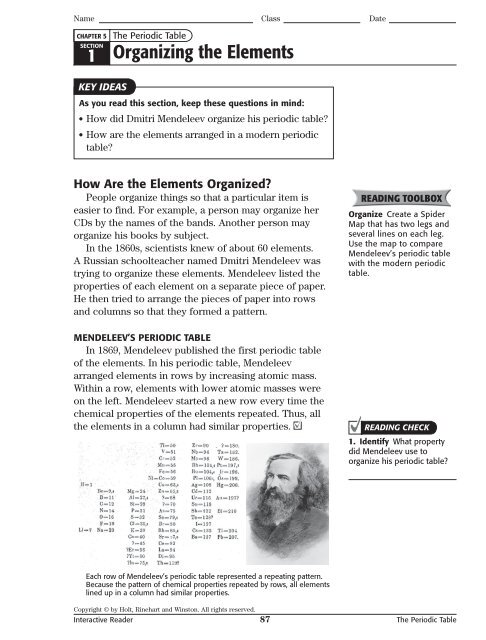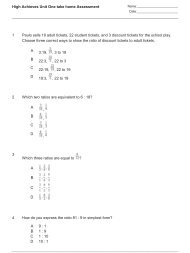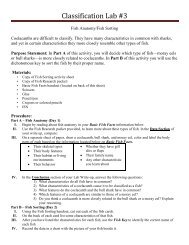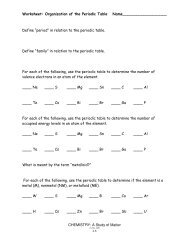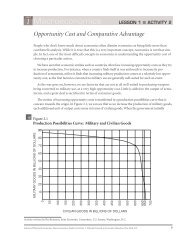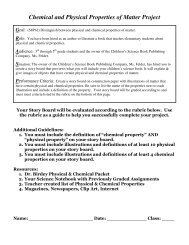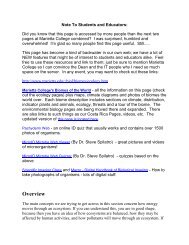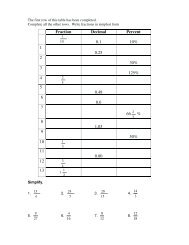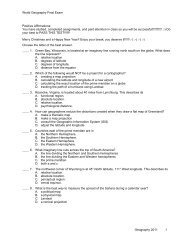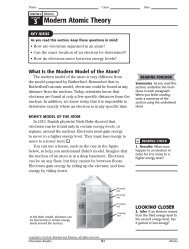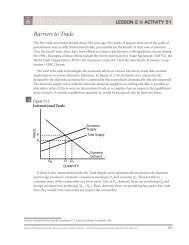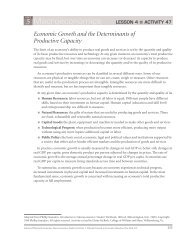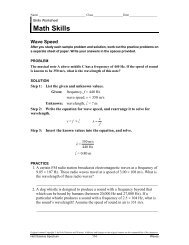1 Organizing the Elements
1 Organizing the Elements
1 Organizing the Elements
Create successful ePaper yourself
Turn your PDF publications into a flip-book with our unique Google optimized e-Paper software.
Name Class DateCHAPTER 51 <strong>Organizing</strong> <strong>the</strong> <strong>Elements</strong>SECTIONThe Periodic TableKEY IDEASAs you read this section, keep <strong>the</strong>se questions in mind:• How did Dmitri Mendeleev organize his periodic table?• How are <strong>the</strong> elements arranged in a modern periodictable?How Are <strong>the</strong> <strong>Elements</strong> Organized?People organize things so that a particular item iseasier to find. For example, a person may organize herCDs by <strong>the</strong> names of <strong>the</strong> bands. Ano<strong>the</strong>r person mayorganize his books by subject.In <strong>the</strong> 1860s, scientists knew of about 60 elements.A Russian schoolteacher named Dmitri Mendeleev wastrying to organize <strong>the</strong>se elements. Mendeleev listed <strong>the</strong>properties of each element on a separate piece of paper.He <strong>the</strong>n tried to arrange <strong>the</strong> pieces of paper into rowsand columns so that <strong>the</strong>y formed a pattern.MENDELEEV’S PERIODIC TABLEIn 1869, Mendeleev published <strong>the</strong> first periodic tableof <strong>the</strong> elements. In his periodic table, Mendeleevarranged elements in rows by increasing atomic mass.Within a row, elements with lower atomic masses wereon <strong>the</strong> left. Mendeleev started a new row every time <strong>the</strong>chemical properties of <strong>the</strong> elements repeated. Thus, all<strong>the</strong> elements in a column had similar properties.READING TOOLBOXOrganize Create a SpiderMap that has two legs andseveral lines on each leg.Use <strong>the</strong> map to compareMendeleev’s periodic tablewith <strong>the</strong> modern periodictable.READING CHECK1. Identify What propertydid Mendeleev use toorganize his periodic table?Each row of Mendeleev’s periodic table represented a repeating pattern.Because <strong>the</strong> pattern of chemical properties repeated by rows, all elementslined up in a column had similar properties.Copyright © by Holt, Rinehart and Winston. All rights reserved.Interactive Reader 87 The Periodic Table
Name Class DateSECTION 1<strong>Organizing</strong> <strong>the</strong> <strong>Elements</strong> continuedREADING CHECK2. Explain Why didMendeleev leave gaps in <strong>the</strong>periodic table?PREDICTING ELEMENTSWhen Mendeleev arranged <strong>the</strong> elements in a table, heleft gaps, or spaces, in <strong>the</strong> table. Look again at Mendeleev’stable on <strong>the</strong> last page. Notice that Mendeleev includedquestion marks in his table. The question marks representedelements with certain properties that scientists hadnot discovered yet. Because he saw patterns of chemicalproperties, Mendeleev predicted that scientists wouldeventually find <strong>the</strong> elements that filled those gaps.Mendeleev was not <strong>the</strong> only person to develop aperiodic table. However, he was <strong>the</strong> first to use <strong>the</strong> tableto make predictions. For example, Mendeleev left a spacein his table for an element after silicon. He predicted thatthis element would be a gray metal that had a highmelting point. In 1886, <strong>the</strong> element germanium wasdiscovered.Properties of GermaniumMendeleev’spredictionActualPropertyAtomic mass 70 72.6Density 5.5 g/cm 3 5.3 g/cm 3Appearance Dark gray metal Gray metalloidMelting point High 937 °CGermanium has <strong>the</strong> properties similar to those that Mendeleev predicted.READING CHECK3. Explain Why didMendeleev have problemsarranging <strong>the</strong> elements Teand I?PROBLEMS WITH MENDELEEV’S TABLEMendeleev found that some elements did not fit <strong>the</strong>pattern in his table. For example, Mendeleev had to placetellurium (Te) before iodine (I) in his table so that <strong>the</strong>yfit <strong>the</strong> pattern of chemical properties. However, whenhe switched Te and I, <strong>the</strong>y were no longer in order ofincreasing atomic mass.Mendeleev thought that <strong>the</strong> values for <strong>the</strong> atomicmasses of Te and I might be incorrect. He thought thatcareful measurements would show that <strong>the</strong> atomic massof Te was actually less than that of I. However, measurementsby o<strong>the</strong>r scientists showed that <strong>the</strong> atomic massesof <strong>the</strong> two elements were correct. This problem wasfinally solved about 40 years later by an English chemistnamed Henry Moseley.Copyright © by Holt, Rinehart and Winston. All rights reserved.Interactive Reader 88 The Periodic Table
Name Class DateSECTION 1<strong>Organizing</strong> <strong>the</strong> <strong>Elements</strong> continuedHow Is <strong>the</strong> Periodic Table Organized Today?Unlike Mendeleev, Mosely did not organize elementsby increasing atomic masses. Instead, he organized <strong>the</strong>elements into a periodic table by atomic number. Recallthat an element’s atomic number is <strong>the</strong> number ofprotons in an atom of <strong>the</strong> element.The new way of organizing did not change <strong>the</strong>locations of most elements in <strong>the</strong> periodic table.However, a few elements, including Te and I, did move.Although Te has a higher atomic mass than I, it hasa lower atomic number. Thus, Mosely could place Tebefore I in <strong>the</strong> periodic table without disturbing <strong>the</strong>pattern of chemical properties.The modern periodic table has more than 100 elements,and organizes <strong>the</strong> elements by atomic number. Becauseelements are arranged by atomic number, elementswith similar properties are located in <strong>the</strong> same column.Therefore, <strong>the</strong> properties of <strong>the</strong> elements on <strong>the</strong> periodictable repeat at regular intervals. This principle is known as<strong>the</strong> periodic law.PERIODS AND GROUPSA horizontal row on <strong>the</strong> periodic table is called aperiod. There are seven periods on <strong>the</strong> periodic table. Theproperties of <strong>the</strong> elements in a period are different. Avertical column on <strong>the</strong> periodic table is called a group. All<strong>the</strong> elements in a group have similar chemical properties. READING CHECK4. Identify What propertydid Mosely use to organize<strong>the</strong> periodic table?5. Compare Whichinformation helps youpredict <strong>the</strong> properties of anelement—<strong>the</strong> period it is in,or <strong>the</strong> group it is in? Explainyour answer. Copyright © by Holt, Rinehart and Winston. All rights reserved.Interactive Reader 89 The Periodic Table
Name Class DateSection 1 ReviewSECTION VOCABULARYgroup a vertical column of elements in <strong>the</strong>periodic table; elements in a group sharechemical propertiesperiod in chemistry, a horizontal row ofelements in <strong>the</strong> periodic tableperiodic law <strong>the</strong> law that states that <strong>the</strong>repeating chemical and physical properties ofelements change periodically with <strong>the</strong> atomicnumbers of <strong>the</strong> elements1. Compare Find oxygen, sulfur, and fluorine in <strong>the</strong> periodic table in <strong>the</strong> back of <strong>the</strong>book. Are <strong>the</strong> chemical properties of oxygen more similar to those of sulfur or tothose of fluorine? Explain your answer.2. Identify Complete <strong>the</strong> table below to describe several elements. Use <strong>the</strong> periodictable in <strong>the</strong> back of <strong>the</strong> book to help you. Round off atomic masses to <strong>the</strong> nearestwhole number. For example, change 15.9994 to 16.Element Symbol Atomic number Atomic mass Period GroupGold474 2Fe3. Predict If scientists found element 117, into which period and group would<strong>the</strong>y place it? Identify one element that would have properties similar to those ofelement 117.4. Infer Before 1937, scientists had not found element 43. Chemists predicted <strong>the</strong>properties of element 43. How was it possible for chemists to predict <strong>the</strong>seproperties?Copyright © by Holt, Rinehart and Winston. All rights reserved.Interactive Reader 90 The Periodic Table


